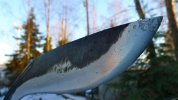*Test cutting and extreme cutting principles*
Edge profile:
HI khuks are made with different edge geometry, which can mean there are different khuks for different tasks. I would not use a thinly profiled blade to cut wood, but it'd do a job on reeds, brambles, grass, underbrush (i.e Gelbu special). I would not use a thicker profiled blade to cut lighter targets, but it would be perfect for chopping lots of wood or harder test targets. The more obtuse the blade geometry, the better the blade will hold up to extreme cutting--conversely, it may not cut as deeply as a thinner model.
Confirm your target:
Know the composition of your target, and ensure that it is not harder than your khuk.
When cutting certain high carbon or spring steels could really chew up a khuk. You can test target hardness by runnng the hardened area of the khuk along the target material, like peeling a carrot or shaving a sliver from a stick. If the khuk cuts or bites into the material, then you pretty well know how things are gonna go. If the surface is resistant to the khuk and the khuk will not bite, then you'd be better off not striking the target. Keep in mind that it is possible to successfully cut small amounts or thin pieces of material as hard as the khuk by exercising the principles in 1-5. Proper technique can make all the difference.




